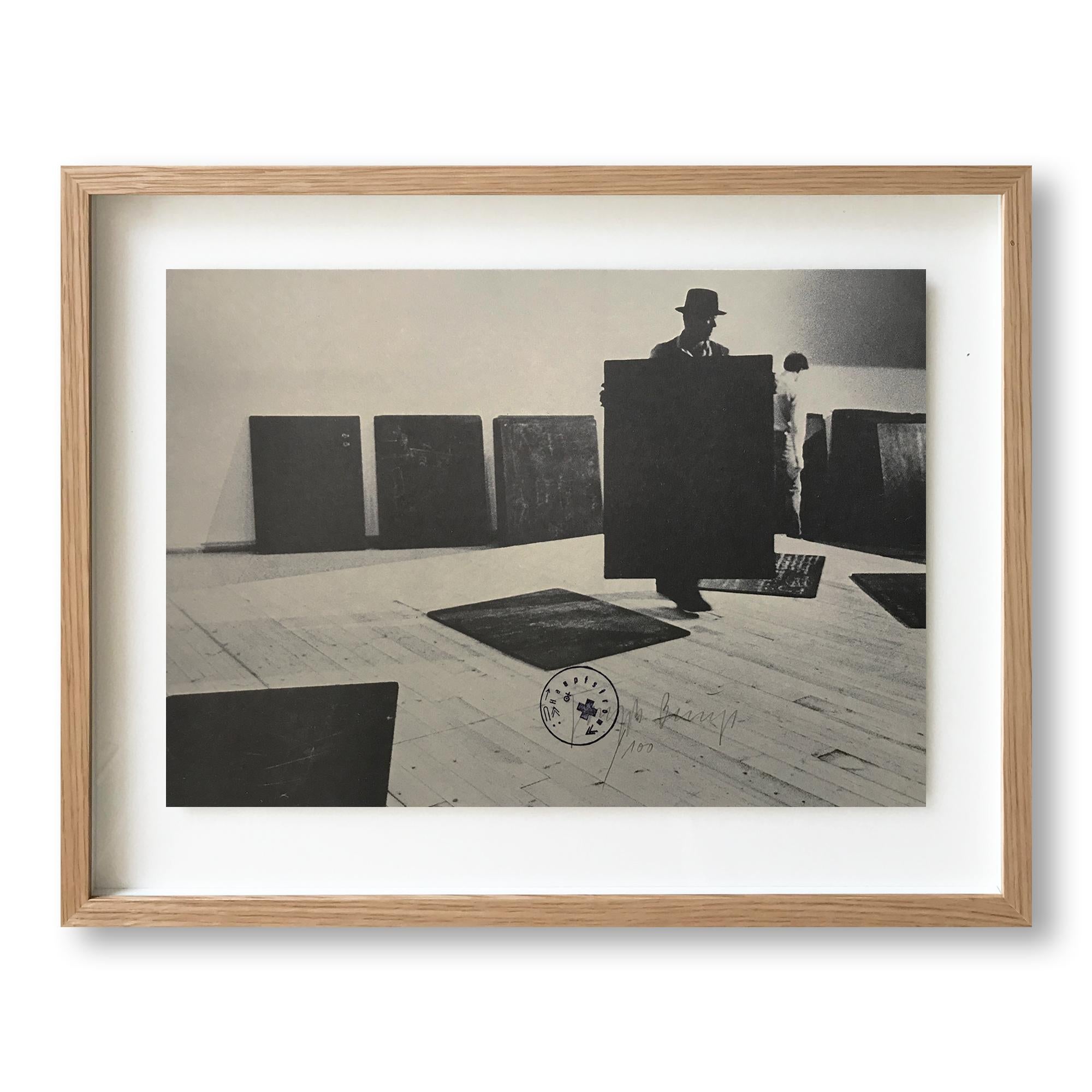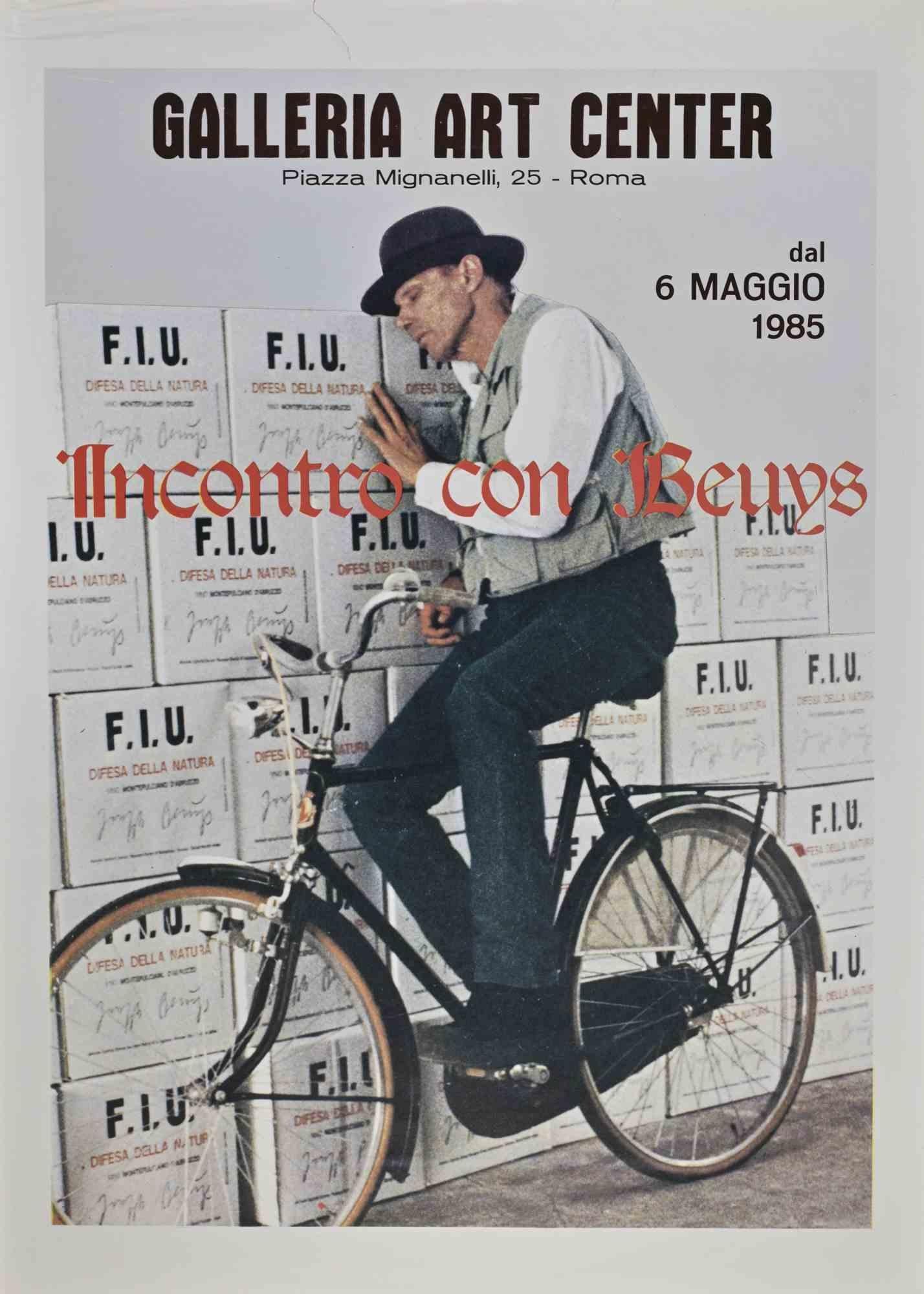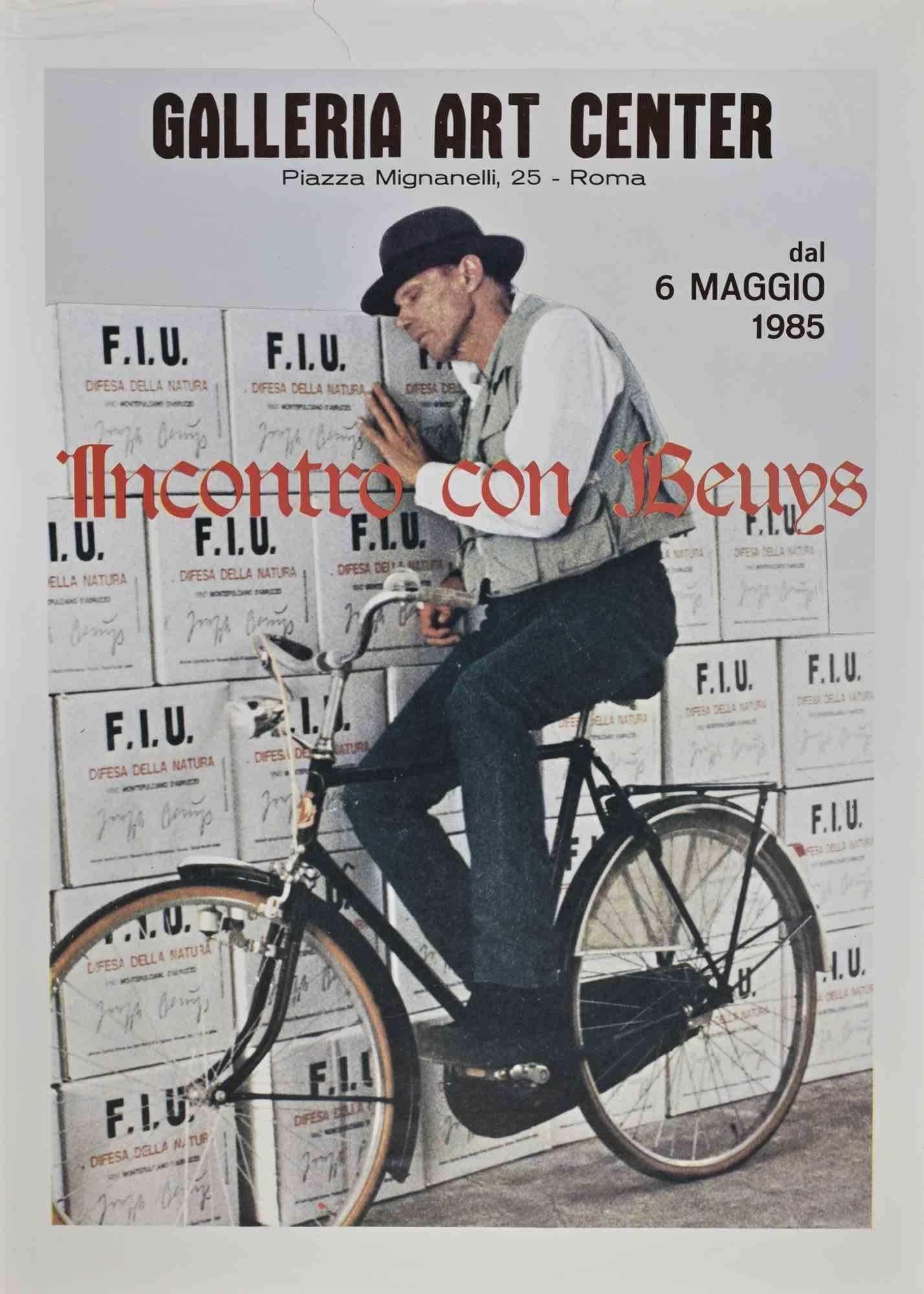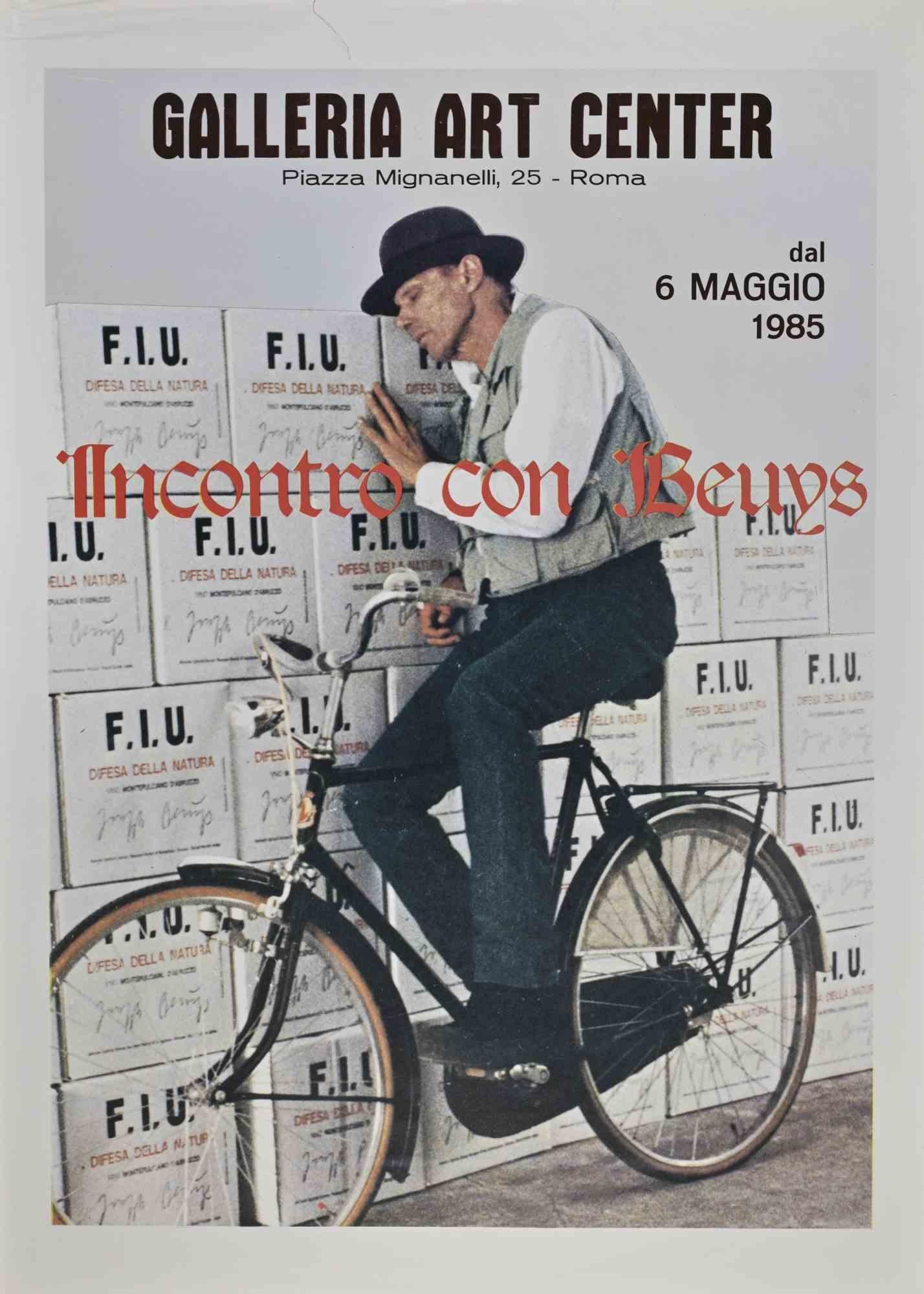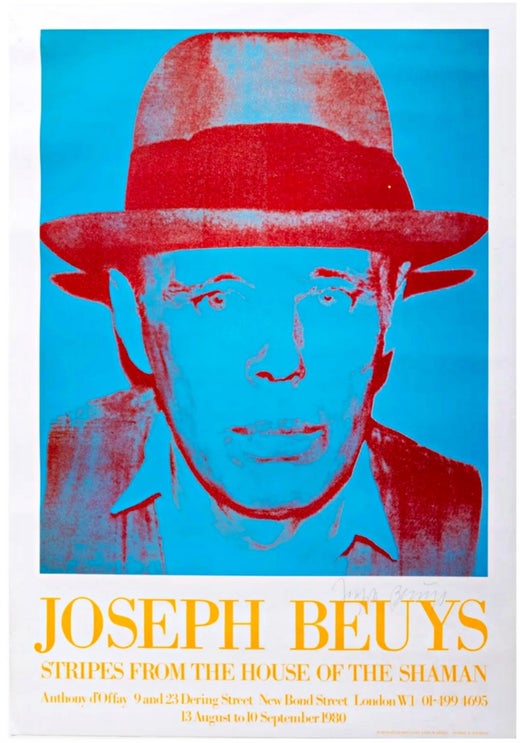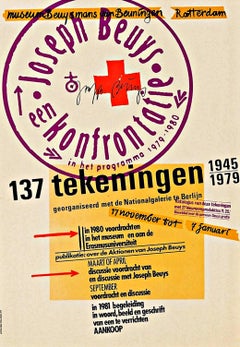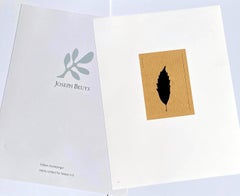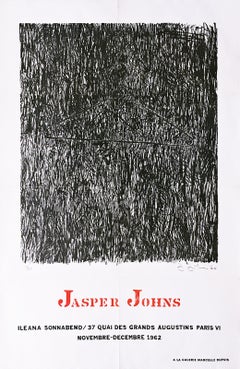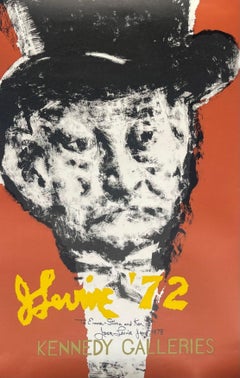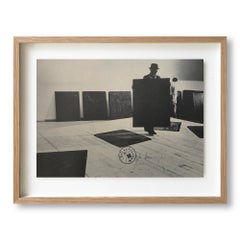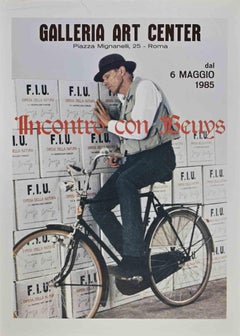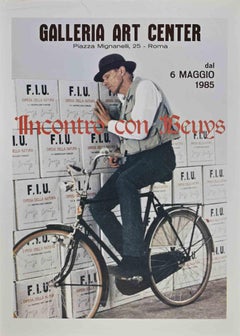Items Similar to Stripes from the House of the Shaman Rare print Hand Signed ink by Joseph Beuys
Want more images or videos?
Request additional images or videos from the seller
1 of 8
Joseph BeuysStripes from the House of the Shaman Rare print Hand Signed ink by Joseph Beuys1980
1980
$5,950
£4,584.31
€5,236.71
CA$8,518.47
A$9,291.10
CHF 4,885.17
MX$111,497.30
NOK 61,680.65
SEK 57,531.22
DKK 39,110.55
About the Item
Joseph Beuys
Stripes from the House of the Shaman (Hand Signed), 1980
Silkscreen exhibition poster with offset lettering on wove paper; hand signed by Joseph Beuys
Boldly signed on the front in graphite pencil by Joseph Beuys
Published by: Anthony D'Offay Gallery, London
Frame included: held in original vintage frame
From the estate and collection of artist Tom Levine. Very rare when hand signed as is the present work. Vintage frame is included with this work. (see other photos)
Measurements:
Framed: 32.5 inches (vertical) by 24 inches (horizontal) by 1 inch (depth)
Print: 28.5 inches (vertical) by 19.5 inches (horizontal)
More about Joseph Beuys:
Joseph Beuys, who is recognized as one of the most influential artists of the postwar period, had a grand and ambitious goal for his work: the transformation of Western culture into a more peaceful, democratic, and creative milieu. His multifaceted career, which included sculpture, performance, lectures, activism, and even a campaign for elected office, were all part of an “expanded concept of art” that was aimed at advancing his utopian vision. In all its forms, his work is dense and highly allusive and draws on much of the accumulated knowledge of Western civilization, including history, religion, natural sciences, economic theory, and myth. A charismatic teacher, Beuys was mentor to a generation of younger artists who were inspired by his passionate fusion of art, life, and activism.
Service in World War II
Beuys was born in Krefeld, Germany, and as a youth pursued dual interests in art and the natural sciences. In 1940, at age 19, he joined the German air force. During his 5 years of service, he was wounded several times and interned in a British prisoner-of-war camp. He returned home in 1945 physically and emotionally depleted, and spent nearly a decade recuperating on a friend’s farm, where he made hundreds of drawings and small sculptures. Coming to terms with his involvement in World War II would be a lifelong process that informed much of his art.
Teaching at the Düsseldorf Art Academy, Sled
After the war, Beuys decided to dedicate himself to art. In 1961, he was appointed to a professorship at the Düsseldorf Art Academy and soon became the school’s most sought-after teacher. At the same time, he began to develop his sculptural practice. One of his best-known works from this period is Sled (1969), which he called a “survival kit”: an elemental means of transport carrying a felt blanket, a lump of fat, and a flashlight. Sled alludes to Beuys’s oft-repeated story of crashing his warplane during a blizzard and being rescued by Tatar nomads, who treated his wounds with fat and wrapped him in felt to keep him warm. Whether true or not, the story is a powerful metaphor for the rebirth of both an individual and a nation after the horrors perpetrated by National Socialism.
I Like America and America Likes Me
Beuys was also a performer who was renowned for his “actions”—heavily symbolic events that illustrated his evolving ideas about how art could play a wider role in transforming society. The best known of these is I Like America and America Likes Me (1974), in which he spent several days with a coyote in a New York gallery space. Described as a “dialogue” with the animal, the performance presented Beuys as a shaman—a spiritual leader and healer who has a special affinity with animals—who traveled to the United States to enact a symbolic reconciliation between modern American society, the natural world, and Native American culture. To emphasize the urgent need for healing these rifts, Beuys had himself transported to and from the gallery in an ambulance.
“Everyone is an artist,” Political Activism, 7000 Oaks
During the 1970s, Beuys focused much of his energy on political activism, helping to found such groups as the German Student Party, the Free International University, and the Green party, whose goals included worldwide disarmament, educational reform, and environmental stewardship. His well-known slogan, “Everyone is an artist,” was meant to suggest that social transformation could be achieved if every human being applied his or her creative energies toward positive change in cooperative activities he called “social sculptures.” His most famous of these was 7000 Oaks (1982), a massive reforestation project in which seven thousand trees were planted throughout Germany, particularly in areas destroyed by bombing during World War II. In 1997, in homage to his idea, the Walker Art Center oversaw the planting of more than 1,000 young trees in Cass Lake, St. Paul, and the Minneapolis Sculpture Garden.
Recognition and Legacy
Beuys’s work has been collected and shown widely in Europe and the United States, with major retrospectives mounted by the Guggenheim Museum (1979) and Tate Modern (2005), among others. Large collections of his multiples are held by several American institutions, including the Walker Art Center and the Broad Art Foundation in Los Angeles. In 1986, Beuys was awarded the Wilhelm Lehmbruck Prize by the city of Duisburg, Germany.
While the success of Beuys’s ambitious program has been the subject of much debate, his enormous influence on the development of postwar art is undeniable. His exploration of sculptural form and materials, his mesmerizing performances, and his ideas about the powerful potential of consciously applied creativity are still catalytic forces in the art world.
-Courtesy of the Walker Art Center
- Creator:Joseph Beuys (1921 - 1986, German)
- Creation Year:1980
- Dimensions:Height: 32.5 in (82.55 cm)Width: 24 in (60.96 cm)Depth: 1 in (2.54 cm)
- Medium:
- Movement & Style:
- Period:
- Condition:Held in the original vintage frame; ships framed.
- Gallery Location:New York, NY
- Reference Number:1stDibs: LU1745216270042
Joseph Beuys
Beuys was born in Krefeld, Germany in 1921. Several months after his birth, the family moved to Kleve, close to the German-Dutch border. His talent for drawing was immediately spotted, and he visited the studio of the Flemish painter Achilles Moorgat as a child, which he later cites as inspirational to his own desires to pursue a career as an artist. In 1936, Beuys became a member of the compulsory Hitler Youth, and after graduating from school in 1941 he volunteered for the Luftwaffe. He began military training under the tutelage of Heinz Sielmann, and simultaneously attended lectures in Biology and Zoology. In 1942, Beuys was stationed in the Crimea.
In 1944, Beuys’ plane crashed on the Crimean Front. Following this incident, Beuys was deployed to the Western Front, where in 1945 he was taken prisoner in Cuxhaven and bought to a British internment camp. He was released on the 5th of August, 1945, returning home to Kleve. Following his return home, Beuys joined the Kleve Artists Association, and enrolled in the Monumental Sculpture program at the Düsseldorf Academy of Fine Arts. In 1947, Beuys co-founded the artistic group Donnerstag-Gesellschaft which organized discussions, exhibitions, events and concerts between 1947 and 1950.
In 1951, Beuys shared a studio with Erwin Heerich that he kept for three years until after his graduation. Beuys graduated as a master student in 1953, and throughout the 1950s, struggled to successfully live off the income his art was bringing in. In 1961, Beuys was appointed a professor at Kunstakademie Düsseldorf. In 1964, Beuys’ performance at the Technical College Aachen began his launch into public consciousness. The following year, Beuys held a solo exhibition at the Galerie Schmela, Düsseldorf. Two years later, Beuys exhibited solo in Austria and Germany again, which he continued to do almost yearly throughout his career. In 1975-1976, Beuys represented Germany at the Venice Biennale. In 1979, Beuys held an exhibition at the Solomon R. Guggenheim Museum in New York, and represented Germany at the Venice Biennale once more in 1980. There was a retrospective held for Beuys in 1984 at the Seibu Museum of Art, Tokyo. Notably, Beuys was given a retrospective at the Tate Modern, London in 2005 and at the Museum of Modern Art in New York in 2008, and has been at the center of the international art scene since.
Beuys is collected worldwide, including at the Galerie aKonzept, Berlin; the Thomas Ammann Fine Art, Zurich; the Nohra Haime Gallery, New York; the Galerie Kluser, Munich; the Galerie Schwarzer, Dusseldorf; the Richard Saltoun Gallery, Londoon and the Plazzart Paris, France.
About the Seller
5.0
Platinum Seller
Premium sellers with a 4.7+ rating and 24-hour response times
Established in 2007
1stDibs seller since 2022
465 sales on 1stDibs
Typical response time: 2 hours
- ShippingRetrieving quote...Shipping from: New York, NY
- Return Policy
More From This Seller
View AllJoseph Beuys, een konfrontatie, 137 Tekeningen 1945-1979, Hand Signed print Rare
By Joseph Beuys
Located in New York, NY
Joseph Beuys
Joseph Beuys, een konfrontatie, 137 Tekeningen 1945-1979, (Hand Signed), 1979
Silkscreen on velincarton (thin board)
Catalogue raisonne reference: Weiss-Britsch 75
Boldl...
Category
1970s Conceptual Abstract Prints
Materials
Board, Offset
Joseph Beuys, Blatt auf Karteikarte, from Columbus: In Search of a New Tomorrow
By Joseph Beuys
Located in New York, NY
Joseph Beuys
Blatt auf Karteikarte (from Columbus: In Search of a New Tomorrow), 1992
Color silkscreen on vellum parchment paper, held in original portfolio sleeve
Signed by Eva Beuy...
Category
1990s Conceptual Abstract Prints
Materials
Vellum, Screen
Jasper Johns at Ileana Sonnabend (rare early mid century modern European poster)
By Jasper Johns
Located in New York, NY
Jasper Johns
Jasper Johns at Ileana Sonnabend, 1962
Offset Lithograph exhibition poster/invitation
Plate signed on the front
31 3/4 × 21 inches
Unframed
This rare, collectible vintage poster...
Category
1960s Pop Art Abstract Prints
Materials
Offset
Vintage 1970s Kennedy Galleries poster, Hand signed & warmly inscribed by artist
By Jack Levine
Located in New York, NY
Jack Levine
Vintage 1970s Kennedy Galleries poster (Hand signed and warmly inscribed), 1972
Offset lithograph poster (Signed, dated and inscribed in black marker by Jack Levine)
Sign...
Category
1970s Expressionist Portrait Prints
Materials
Lithograph, Offset
Rare Philadelphia Museum of Art exhibition poster (Hand Signed by Jasper Johns)
By Jasper Johns
Located in New York, NY
Jasper Johns, Prints, 1960-70 (Hand Signed by Jasper Johns), 1970
Offset lithograph poster (signed by Jasper Johns)
Boldly signed in black marker on the front
35 × 23 1/2 inches
Published by the Philadelphia Museum of Art
The artwork depicted in the poster is Jasper Johns lithograph...
Category
1970s Pop Art Abstract Prints
Materials
Lithograph, Offset
Robert Rauschenberg at Leo Castelli poster (postmarked to artist Ludwig Sander)
By Robert Rauschenberg
Located in New York, NY
Robert Rauschenberg
Robert Rauschenberg at Leo Castelli (postmarked to artist Ludwig Sander), 1960
Offset lithograph poster
19 × 26 inches
Unframe...
Category
1960s Pop Art Abstract Prints
Materials
Offset
You May Also Like
Joseph Beuys, Aufbau - Signed Print, 1977, Conceptual Art, Fluxus, Modern Art
By Joseph Beuys
Located in Hamburg, DE
Joseph Beuys (German, 1921-1986)
Title: Aufbau, 1977
Medium: Offset on grey cardboard, stamped
Dimensions: 30.5 x 43 cm
Edition of 100: Hand-signed and numbered in pencil
Publisher: ...
Category
20th Century Contemporary Figurative Prints
Materials
Offset
Beuys' Exhibition - Original Poster - 1985
Located in Roma, IT
Beuys' Exhibition "meeting with Beuys" is a poster realized for the Marino Gallery - Galleria Art Center (in Piazza Mignanelli, Rome) where Joseph Beuys' Exhibition was held in 1985...
Category
1980s Contemporary Figurative Prints
Materials
Paper
Beuys' Exhibition - Original Poster - 1985
Located in Roma, IT
Beuys' Exhibition "meeting with Beuys" is a poster realized for the Marino Gallery - Galleria Art Center (in Piazza Mignanelli, Rome) where Joseph Beuys' Exhibition was held in 1985...
Category
1980s Contemporary Figurative Prints
Materials
Paper
Beuys' Exhibition - Original Poster - 1985
Located in Roma, IT
Beuys' Exhibition "meeting with Beuys" is a poster realized for the Marino Gallery - Galleria Art Center (in Piazza Mignanelli, Rome) where Joseph Beuys' Exhibition was held in 1985...
Category
1980s Contemporary Figurative Prints
Materials
Paper
Beuys' Exhibition - Original Poster - 1985
Located in Roma, IT
Beuys' Exhibition "meeting with Beuys" is a poster realized for the Marino Gallery - Galleria Art Center (in Piazza Mignanelli, Rome) where Joseph Beuys' Exhibition was held in 1985...
Category
1980s Contemporary Figurative Prints
Materials
Paper
Beuys' Exhibition - Original Poster - 1985
Located in Roma, IT
Beuys' Exhibition "meeting with Beuys" is a poster realized for the Marino Gallery - Galleria Art Center (in Piazza Mignanelli, Rome) where Joseph Beuys' Exhibition was held in 1985...
Category
1980s Contemporary Figurative Prints
Materials
Paper
